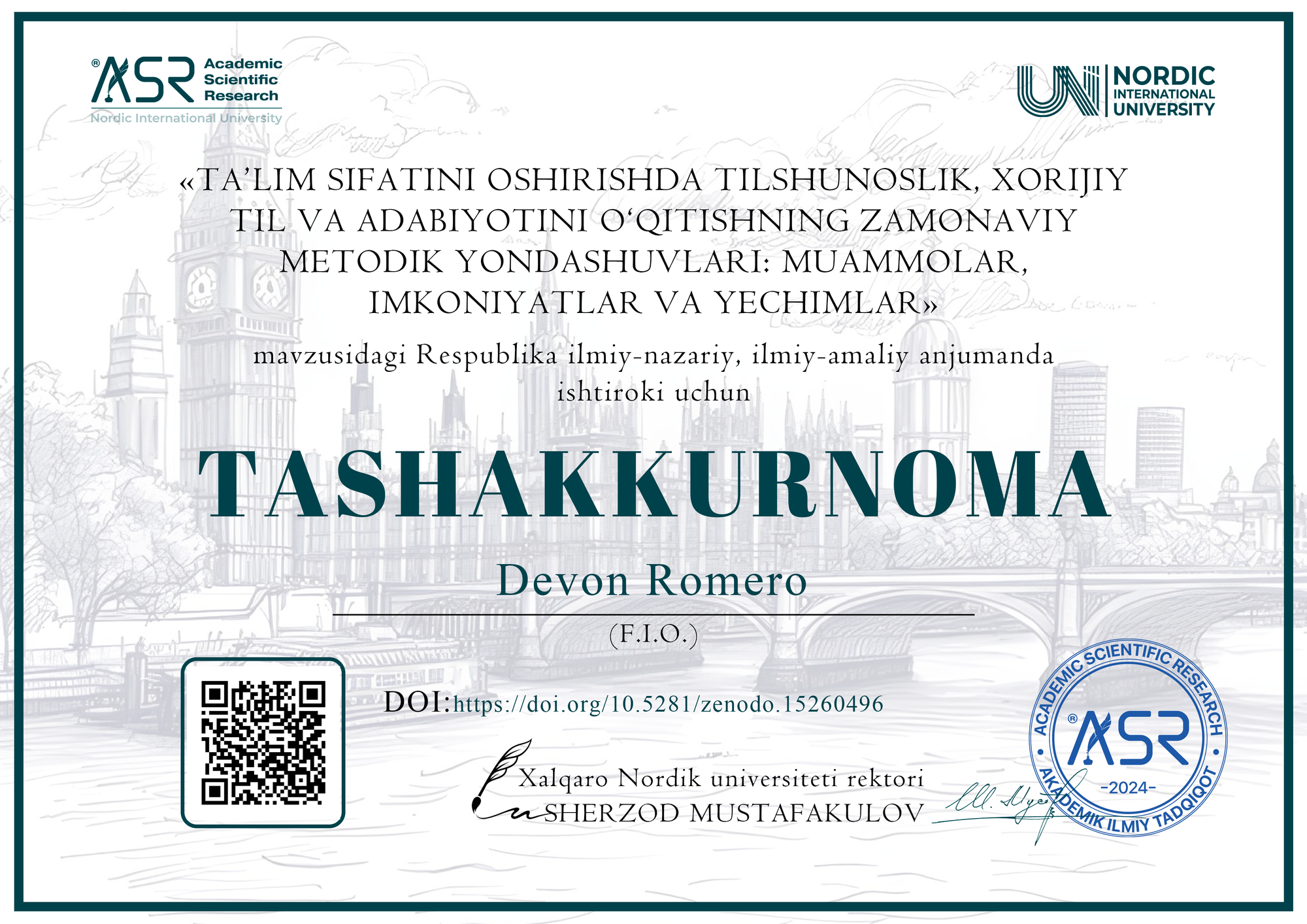
Devon Romero

DOI: https://doi.org/10.5281/zenodo.15260496
Nordic_press journal: https://research.nordicuniversity.org/index.php/nordic/article/view/2372
TASHAKKURNOMA
TEACHING METHODS THROUGH EXPERIENCE
Devon Romero
English as a Foreign Language Teacher at School -294
Hello, everyone.
My name is Devon Romero. I’m originally from the United States and have been teaching here in Uzbekistan for the past 8 months, during the 2024 - 2025 academic year. Before coming to Tashkent, I graduated from the University of Colorado – Boulder with a degree in English. I then worked in Denver Public Schools as a Restorative Practice Coordinator. That role focused heavily on conflict resolution, primarily among students and faculty, and helping at-risk students learn how to manage their emotions in a school setting.
Outside the classroom, I also organized a mentoring program for young boys, designed to get them more involved in the local community and to prepare them for university life.
I came to Uzbekistan primarily out of a desire to explore a new part of the world. I had lived abroad before, in a few places, and was eager to do so again. I'm from a very mountainous region of the U.S., so I was particularly excited about experiencing the nature and landscapes here. To be honest, I didn’t have many expectations when it came to the classroom experience, but I’ve been pleasantly surprised by how eager and motivated the students in Tashkent are to learn and improve their English.
In the classroom, my methodology is a bit of a blend. I primarily use Communicative Language Teaching (CLT), the Lexical Approach, and The Direct Method, with a little bit of Grammar-Translation sprinkled in when necessary.
CLT, for me, is central because it focuses on interaction and real-world communication. The goal isn’t just to memorize grammar rules, but to actually use the language meaningfully. The Lexical Approach helps students understand that language is more than grammar. It's also about colloquialisms, idioms, and recognizing patterns in how words are naturally grouped together.
The Direct Method allows me to encourage full immersion in English. This emphasizes listening and speaking from the beginning and I find it’s really effective in building student confidence. And occasionally, I do fall back on Grammar-Translation, especially when working with more complex sentence structures, however, I most often employ this approach when having students explain things about Uzbek culture to me.
My background in conflict resolution has definitely influenced my teaching style. I’ve become very comfortable holding conversations, guiding discussions, and resolving misunderstandings. And honestly, being “chronically online,” as some students might say, has helped too. I tend to be aware of internet culture, trends, and memes that students engage with, even if they’re consuming that content in different languages. It helps us connect and keeps the classroom environment current and relevant.
Of course, teaching in Uzbekistan has required some adaptation. Americans, especially those who go abroad, can be pretty casual, and I’ve found that letting students take a bit more ownership over the lesson, like choosing the game we play or leading a discussion, helps keep them more engaged. They feel like their voices matter, and that leads to better participation. Some days are just them asking me questions about my life and experiences, with me answering them, and vice versa.
That said, there have been challenges. In the public schools where I teach, resources are limited. I primarily teach grades 9, 10, and 11. These are students who have grown up with smartphones and social media. It’s tough to compete for their attention when my main tools are a chalkboard and a textbook. So boredom is often an issue.
To address that, I try to bring in multimedia when I can—clips from movies, short videos, anything that adds energy and variety. Students also respond really well to competitive games. Jeopardy and Bingo are especially popular. And for the younger students, physical games like Simon Says or Heads Up, 7 Up get them up and moving, which helps with focus and retention.
Another adjustment I made was to shift away from grammar-heavy lessons, since I found that most students already had a strong foundation. Instead, I began focusing more on speaking, listening, and writing, which gave them a chance to put their grammar knowledge into practice.
One final challenge worth mentioning is the culture of extra lessons. Many students attend private tutoring sessions outside of school at private institutions and centers, so sometimes they don’t see regular school lessons as valuable. My approach has been to make the classroom fun, engaging, and relevant, so that it doesn’t feel like just another class, but a space where they can really use their English creatively.
In the end, the moments that stand out the most—the successes—are often the simplest ones: students laughing while playing Jeopardy, using new vocabulary in conversation without prompting, or even just expressing themselves confidently in English. Those are the moments when you feel like you’re doing something right.
It’s been a joy to share a little bit about my journey, and I hope it’s helpful to hear the perspective of someone bridging two very different educational worlds.
Thank you.



